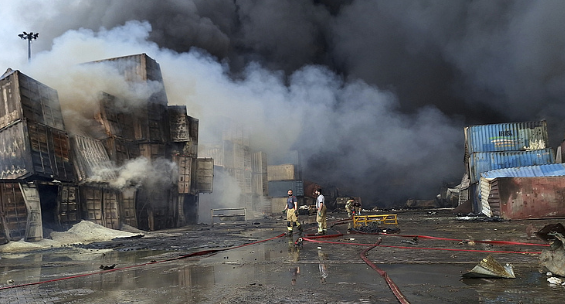Hazardous materials and chemical storage management
On the 26th local time, an explosion occurred in the Abbas port in southern Iran. According to reports, the explosion has injured 561 people and killed at least four people. It is reported that the source of the explosion may come from a dangerous goods and chemical warehouse in the port.

The storage of dangerous goods and chemicals is very different from that of ordinary items. Strict compliance with established management regulations is required.

The storage management regulations for hazardous chemicals mainly include the following aspects:
Basic storage requirements
• Storage methods: There are three types of storage: isolated storage, separated storage, and separate storage.
• Classified storage: According to the properties of hazardous chemicals, they are stored in different areas, categories, and warehouses. All types of hazardous chemicals must not be mixed with prohibited materials.
• Smoking is prohibited in the premises: Smoking and fireworks are strictly prohibited in buildings and areas where hazardous materials are stored.
• Highly toxic management: The managers of warehouses for highly toxic chemicals must achieve "four no's and one guarantee" and abide by the "five pairs" system.
Storage site requirements
• Building specifications: There must be no basements or other underground buildings. The fire resistance level, number of floors, etc. must comply with national regulations, and the impact on the surrounding environment and residents should also be considered.
• Electrical installation: Fire-fighting electrical facilities must meet the needs of fire-fighting electricity, the electrical system must comply with national electrical safety regulations, flammable and explosive places must comply with the electrical safety regulations for explosive places, and the electrical equipment used must be products with explosion-proof certificates, such as explosion-proof monitors and explosion-proof cameras for monitoring.
• Ventilation and temperature control: Install ventilation equipment, the exhaust system has a static-eliminating grounding device, the ventilation ducts are made of non-combustible materials, the heating medium temperature should not be too high, and the pipes and equipment are made of non-combustible materials.
Storage arrangements and limits
• Classification and storage: The storage arrangement of dangerous goods depends on the classification of dangerous goods, the type of container, etc. Dangerous goods that can cause explosions when exposed to fire, moisture, or tide shall not be stored in open air or humid buildings; dangerous goods that can react when exposed to sunlight should be stored in buildings with a fire resistance grade of one and the packaging should be kept away from light.
• Electrical installation: Fire-fighting electrical facilities must meet the needs of fire-fighting electricity, the electrical system must comply with national electrical safety regulations, flammable and explosive places must comply with the electrical safety regulations for explosive places, and the electrical equipment used must be products with explosion-proof certificates, such as explosion-proof monitors and explosion-proof cameras for monitoring.
• Isolation storage: Explosive items are stored separately and in limited quantities; compressed gases and liquefied gases are stored separately from a variety of items, flammable gases are not stored together with combustion-supporting gases, oxygen is not stored mixed with grease, and containers containing liquefied gases are regularly inspected and must not be overloaded. Flammable liquids must not be stored mixed with oxidants, toxic items must be stored in cool places, and corrosive items must be tightly packed and must not coexist with other items.
Dangerous chemical warehouse maintenance
• Warehouse inspection: Strictly inspect the quality, quantity, packaging and leakage of items.
• Regular inspection: Take maintenance measures after entering the warehouse, conduct regular inspections during the storage period, and deal with quality changes and other problems in a timely manner.
• Temperature and humidity control: The temperature of the warehouse should be controlled between -10℃ and +35℃, and the humidity should be strictly controlled, checked frequently, and adjusted in time.
Management of hazardous chemicals in and out of the warehouse
• Establish a system: Establish a strict in and out management system.
• Acceptance registration: Before entering and leaving the warehouse, check and accept and register according to the contract content, including quantity, packaging and hazard signs. If the nature of the items is not clear, they shall not be allowed to enter the warehouse.
• Fire prevention measures: People and vehicles entering the storage area must take fire prevention measures.
• Loading and unloading requirements: Load and unload gently during loading and unloading, and do not drop or bump. When loading and unloading toxic and corrosive items, operators must wear appropriate protective equipment. Materials that are mutually prohibited must not be transported in the same vehicle. When repairing and other operations, use explosion-proof tools that do not produce sparks.
Waste disposal
• Prohibition of stacking: It is prohibited to stack combustible waste in the storage area.
• Container handling: Leaking or leaking packaging containers of hazardous materials should be quickly moved to a safe area.
• Reasonable handling: According to the characteristics of chemical hazardous materials, waste should be handled by chemical or physical methods, and it shall not be discarded arbitrarily to pollute the environment.
